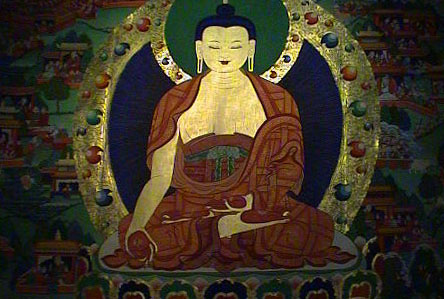One of the difficulties of writing about the early practices of the Bon religion is that no known Bon holy scriptures existed until they were written down in the tenth century. As we have seen, many writers today believe that there may have been a Tibetan script before the time of Songtsen Gampo, but at present we have no manuscripts to prove this.
The earliest known religion of Tibet was not Bon (though some writers refer to it as ‘primitive Bon’) but a simple religion, which saw gods at work in the powers of nature. Like many other primitive cultures around the world, the early Tibetans believed that trees, mountains, rivers, and valleys were all the homes of the gods. These gods had both good and bad sides- just as a river can provide life-giving water but can also destroy life in a bad flood. Simple religious practices grew up around these gods. Offerings of food, incense, and even stones were made at high passes or river crossings, where it was thought the gods lived.
Bon seems to have arrived in Tibet as a new religion after the death of the eighth king of Tibet. It may well have been spread by merchants and traders who came to Tibet from the west- possibly from Persia. Certainly, the scriptures written in the tenth century describe a perfect land in the west called Ol-mo-lung-ring, which was said to be in the shape of an eight-petal flower. According to the scriptures, the founder of the Bon religion was Lord Shenrab. He was one of the three heavenly brothers who wanted to relieve the suffering of all living beings. The first brother, Dagpa, took charge of the past ages, Lord Shenrab the present, and Shespa, who Bon followers believe, is still to come. In Bon holy texts, Lord Shenrab spends much of his time battling with demons. He is said to have visited Tibet in pursuit of a devil who had stolen his seven horses. Once there, he started to teach the Tibetans, but found them unready to receive his doctrines. The Bon holy scriptures were later brought to the Land of Snows by a disciple of one of Shenrab’s followers.
In practice, the Bon religion became very closely linked to the government of the Yarlung kings of Tibet. Bon priests conducted elaborate ceremonies to subdue the evil world of the spirits of dead, and to teach and show the Tibetans the path to the gods of the sky- of which the king of Tibet is believed to be one. Their funeral ceremonies were intended to free man from fear of the dead, and it was their success in doing this that brought the Bon priests their power and influence. Some writers have suggested that it may have been the chief Bon priest who held the real power in the early Tibetan kingdom.
It was only after the royal family adopted Buddhism in the seventh century, and the threat that this posed, that Bon emerged as a fully organized religion. Both religions borrowed or adapted many practices from each other. But they were also rivals, and each went through periods of persecution. In the reign of King Tresong Detsen (755-797), Bon priests were banished from central Tibet and their sacred books were hidden. Many claims were later made about the rediscovery of these books in the tenth century. Whether they were rediscovered or not, the great Bon scholar, Shen Chen Kludga, worked out a doctrine of Bon religious practices, and did much to reconcile Bon with Buddhism. Four great monasteries were founded in the province of Tsang where Bon monks spent their lives in meditation and prayer. Under the Fifth Dalai Lama, Bon once more suffered persecution, but the religion could not be destroyed. Indeed, it has continued to develop, with new teachers and scholars, until the present day.

